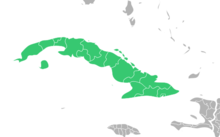
Symphyotrichum is a genus of over 100 species and naturally occurring hybrids of herbaceous annual and perennial plants in the composite family, Asteraceae, most which were formerly treated within the genus Aster. The majority are endemic to North America, but several also occur in the West Indies, Central and South America, as well as one species in eastern Eurasia. Several species have been introduced to Europe as garden specimens, most notably New England aster and New York aster.

Symphyotrichum lateriflorum is a species of flowering plant in the aster family (Asteraceae). Commonly known as calico aster, starved aster, and white woodland aster, it is native to eastern and central North America. It is a perennial and herbaceous plant that may reach heights up to 120 centimeters and widths up to 30 centimeters.

Symphyotrichum eatonii is a species of aster known by the common name Eaton's aster. It is native to much of western North America from British Columbia to Saskatchewan, the Sierra Nevada in California, the Rocky Mountains region, to Arizona and New Mexico, where it grows in many habitats, especially wet areas such as meadows and near ditches. It is also known by the scientific name Symphyotrichum bracteolatum.
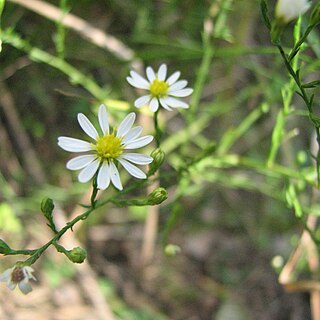
Symphyotrichum depauperatum, commonly known as serpentine aster or starved aster, is a rare species in the family Asteraceae adapted to serpentine barrens, an ecosystem with a high concentration of toxic metals in the soil. It has been found in Pennsylvania, Maryland, and on some diabase glades in North Carolina. It grows to 50 centimeters and has white ray florets surrounding a center of yellow disk florets.

Symphyotrichum dumosum is a species of flowering plant of the family Asteraceae commonly known as rice button aster and bushy aster. It is native to much of eastern and central North America, as well as Haiti and Dominican Republic. It is a perennial, herbaceous plant that may reach a height of 1 meter.
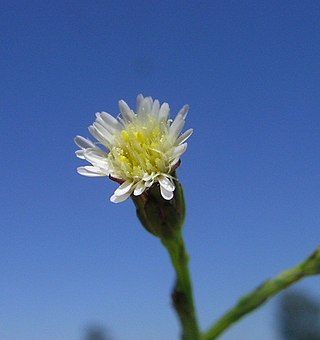
Symphyotrichum subulatum, commonly known as eastern annual saltmarsh aster or, in Britain and Ireland where it is naturalized, annual saltmarsh aster, is an annual plant in the family Asteraceae native to the eastern United States and the Gulf Coast to Texas. The species grows primarily in coastal salt marshes, although in the Ozarks it occurs as a non-marine weedy variety.

Symphyotrichum patens, commonly known as late purple aster or spreading aster, is a perennial, herbaceous plant found in the eastern United States.

Symphyotrichum boreale is a species of flowering plant of the aster family (Asteraceae) native to North America. Commonly known as rush aster, northern bog aster, and slender white aster, it is a perennial, herbaceous plant that may reach heights of 85 centimetres.

Symphyotrichum lucayanum is a species of flowering plant of the aster family (Asteraceae) endemic to the North American island of Grand Bahama.
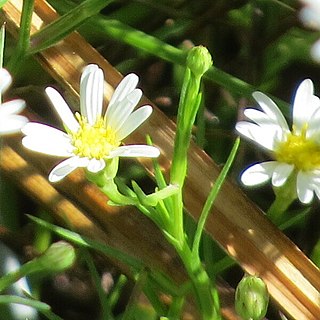
Symphyotrichum potosinum is a species of flowering plant in the family Asteraceae native to Mexico and the U.S. state of Arizona. Commonly known as Santa Rita Mountain aster, it is a perennial, herbaceous plant that may reach heights of 15 to 45 centimeters.

Symphyotrichum patagonicum is a species of flowering plant in the family Asteraceae endemic to the Argentinian provinces of Chubut, Mendoza, Neuquén, and Santa Cruz. It is an annual, herbaceous plant that grows 3 to 30 centimeters tall. Its flowers have short white ray florets in 3 or 4 series and numerous disk florets.

Symphyotrichum regnellii is a species of herbaceous flowering plants in the family Asteraceae native to Argentina and Brazil. It grows to heights of 60 to 120 centimetres, and its flowers have white to pink ray florets that have lengths up to 3 millimetres. It grows in swamps and wet savannas.
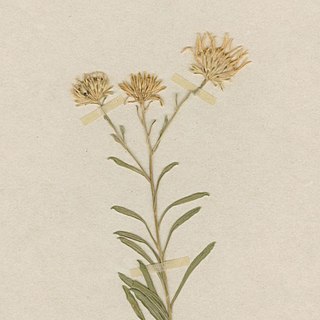
Symphyotrichum burgessii is a species of flowering plant in the family Asteraceae native to Cuba. It is a perennial, herbaceous plant with a height of 5 decimeters or less. Its white ray florets are 5–8 millimeters in length.
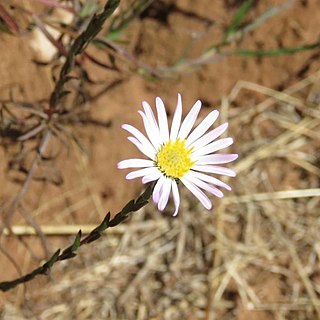
Symphyotrichum moranense is a species of flowering plant in the family Asteraceae. It is a perennial and herbaceous plant that reaches about 90 centimeters in height. Its white ray florets open October through April, and it is native to Mexico.

Symphyotrichum purpurascens is a species of flowering plant in the family Asteraceae native to areas of Mexico and Guatemala.
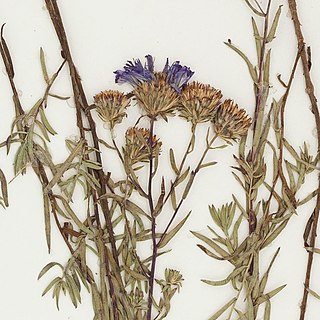
Symphyotrichum turneri is a species of flowering plant in the family Asteraceae native to Durango, Mexico.

Symphyotrichum divaricatum is an annual and herbaceous plant commonly known as southern annual saltmarsh aster. It is native to the southern United States and some northern states of Mexico.

Symphyotrichum parviflorum is an annual and herbaceous plant commonly known as southwestern annual saltmarsh aster. It is native to Mexico, the Caribbean, most of Central America, Ecuador, and the southwestern United States. It is also known by the scientific name Symphyotrichum expansum.

Symphyotrichum kentuckiense is a rare species of flowering plant in the Asteraceae family and is commonly known as Kentucky aster, Price's aster, Miss Price's aster, Sadie's aster, or lavender oldfield aster. It is a perennial, herbaceous plant that is endemic to broken limestone cedar glades and roadsides in Alabama, Georgia, Kentucky, and Tennessee. It blooms from August through October, reaches heights between 30 centimeters and 100 cm (3.3 ft), and has green to reddish-brown stems. It is a nearly hairless plant with blue to blue-violet ray florets.

